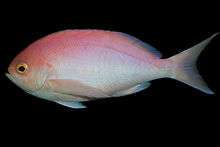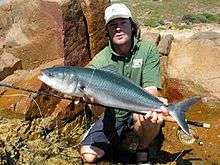Pink maomao
The pink maomao (Caprodon longimanus), also known as the longfin perch, is a species of marine ray-finned fish, a member of the subfamily Anthiinae which is part of the grouper and sea bass family Serranidae. It is found in the southern Pacific and the southeastern Indian Ocean.
| Pink maomao | |
|---|---|
 | |
| Scientific classification | |
| Kingdom: | Animalia |
| Phylum: | Chordata |
| Class: | Actinopterygii |
| Order: | Perciformes |
| Family: | Serranidae |
| Genus: | Caprodon |
| Species: | C. longimanus |
| Binomial name | |
| Caprodon longimanus (Günther, 1859) | |
| Synonyms[2] | |
Description
The pink maomao has long and pointed pectoral fins,[3] longer than the head, a long based dorsal fin and a caudal fin which is slightly forked.[4] The dorsal fin has 10 spines and 19-21 soft rays while the anal fin has 3 spines and 7-9 soft rays. In specimens from the eastern specific there are 58-65 scales in the lateral line while in specimens from the western Pacific there are 61-71 lateral line scales.[2] The females are an overall mauvish pink colour whil the males are a similar colour but may show blackish blotches on the back and upper flanks and on the dorsal fin and males also have yellowish dorsal, caudal, anal and pelvic fins.[3] The maximum recorded fork length is 55 centimetres (22 in)[2] but they are more commonly recorded at fork lengths pf 28–30 centimetres (11–12 in) and they normally weigh around 1 kilogram (2.2 lb) but can reach 2 kilograms (4.4 lb).[5]
Distribution
The pink maomao is found in the southeastern Indian Ocean off Rottnest Island in Western Australia and in the south western Pacific Ocean off eastern Asutralia from Coffs Harbour to Bermagui in New South Wales, around Lord Howe Island and Norfolk Island in the Tasman Sea,[4] the Kermadec Islands south to D'Urville Island and Kaikoura in New Zealand.[3] They also occur in the southeastern Pacific around Easter Island, the Juan Fernandez Islands, the Nazca Ridge and the Isla Salas y Gómez. It has also been reported from the Hawaiian Islands.[1]
Habitat and biology
The pink maomao is found near inshore reefs and its habits are both benthopelagic and benthic. It feeds on zooplankton and small swimming organisms.[2] It can also occur on the outer edge of the continental shelf, and around seamounts.[1] Analysis of stomach contents of fish caught in the Juan Fernandez Islands of Chile showed that this specie sis opportunistic in its choice of prey, the commonest prey item found were salps of the genus Thalia but this study found that a total of 17 genera of crustaceans were consumed, as well as pteropods, chaetognaths and polychaetes.[6] During the day pink maomao form schools, often mixed with silver trevally (Pseudocaranx georgianus), yellowtail horse mackerel (Trachurus novaezelandiae) and blue mackerel (Scomber australasicus), retreateing to rocky areas to spend the night.[5] This species is a protogynous hermaphrodite, they are hatched as females and may change sex to become male.[4] Juvenile fish are only occasionally observed suggesting that this species breeds infrequently in low numbers.[5]
Taxonomy
The pink maomao was first formally described as Anthias longimanus in 1859 by the German-botn British zoologist Albert Günther (1830-1914) with the type locality not being stated but though to be Australia.[7] Studies in New Zealand suggest that there are two species occurring there, one from the Kermadec Islands and the other from the North Island and the west Norfolk Ridge.[3]
Fisheries
The pink maomao has thick, white flesh which is excellent eating and it is pursued by spearfishermen[5] but is infrequently caught by line fishermen.[8] Bag limits are in place in New Zealand.[5]
References
- Williams, J.T.; Carpenter, K.E.; Lawrence, A. & Myers, R. (2016). "Caprodon longimanus". IUCN Red List of Threatened Species. 2016: e.T69584359A69592277. doi:10.2305/IUCN.UK.2016-3.RLTS.T69584359A69592277.en. Retrieved 28 May 2020.
- Froese, Rainer and Pauly, Daniel, eds. (2019). "Caprodon longimanus" in FishBase. December 2019 version.
- P.J. McMillan; et al. (2011). New Zealand fishes. Volume 2: A field guide to less common species caught by bottom and midwater fishing. New Zealand Aquatic Environment and Biodiversity Report. 78. Ministry of Fisheries. p. 128. ISSN 1176-9440.
- Bray, D.J. (2019). "Caprodon longimanus". Fishes of Australia. Museums Victoria. Retrieved 28 May 2020.
- "Pink Maomao". Ocean Hunter. Retrieved 28 May 2020.
- Rojas M José Rodrigo; Palma Sergio & Pequeño R Germán (1998). "Food of the grouper Caprodon longimanus from Alejandro Selkirk Island, Chile (Perciformes: Serranidae)". Revista de Biología Tropical [Internet]. 46 (4): 943–949. Retrieved 28 May 2020.
- Eschmeyer, W. N.; R. Fricke & R. van der Laan (eds.). "Anthias longimanus". Catalog of Fishes. California Academy of Sciences. Retrieved 28 May 2020.
- "Pink maomao". Wild Blue. Retrieved 28 May 2020.
- Ayling, T. & G. Cox. Collins Guide to the Sea Fishes of New Zealand. William Collins Publishers Ltd, Auckland, New Zealand. 1982. ISBN 0-00-216987-8

